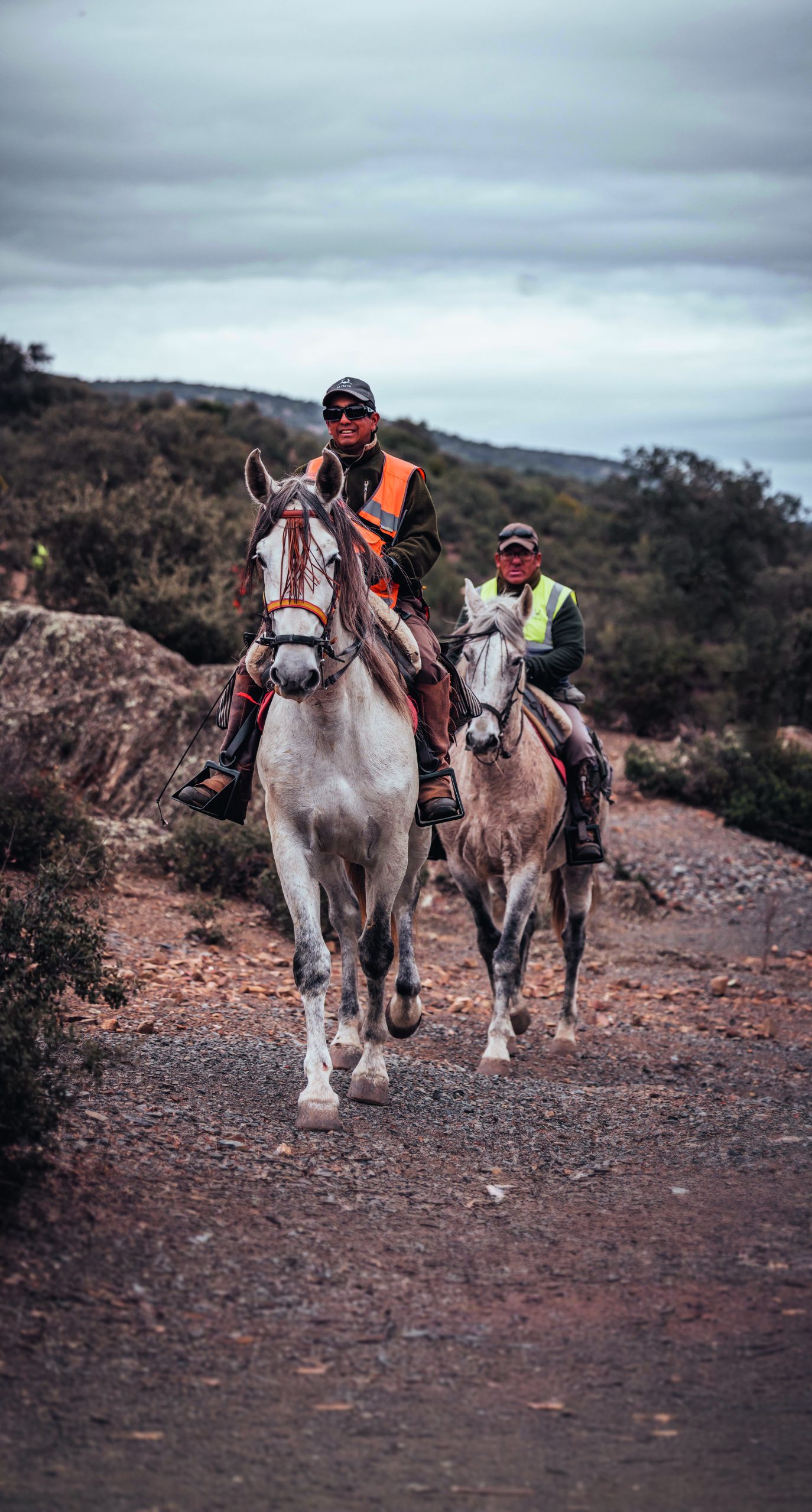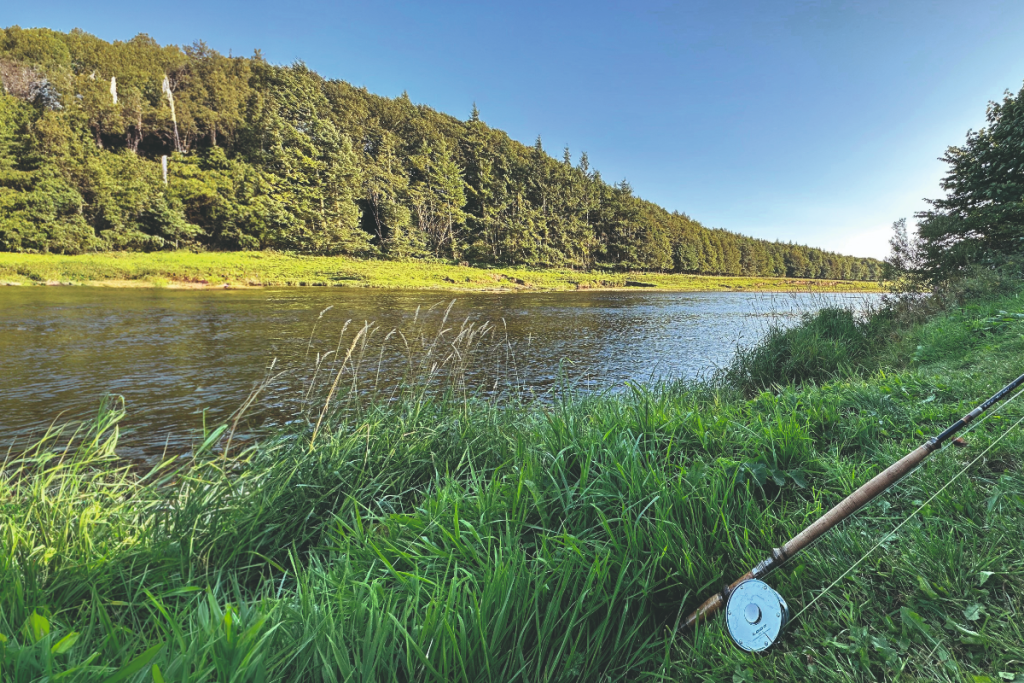Riverbank gundogs
How to enjoy lazy, tranquil days fishing with your dog sitting immaculately on the riverbank.

Imagine this tranquil scene: You in waders, peacefully casting into the river as you stalk wild brownies lying in gin-clear water. Nature all around you. Your loyal, sensible gundog lying on the riverbank sunning himself. So quiet and restful. Utterly restorative and soul nourishing. Your phone is switched off. It’s a perfect antidote to the busy office. Now imagine the sad reality for most: You in waders, constantly having to get out of the river to scream at your dog that refuses to sit still. Next minute he belly-flops into the water and gets tangled in your line. Your blood pressure is at bursting point. After an hour of stress, you pack up and go home raging at your dog. The dream and the reality can be very different. Do not fret though, the first scenario is eminently possible for us all. Start practicing now and you could have a steady riverbank dog to enjoy this summer.
If your gundog loves water as much as it loves game then you will need to have rock solid foundations in place for you to have him on both the field and the riverbank. As we have discussed in previous articles, if he will not sit still on your peg then he is not quite ready for the shooting field. Similarly, if he will not sit still on the riverbank then he is not ready to take fishing. If you are reaching for the corkscrew to tether him to the ground then he is also not ready. The foundations of your dog’s training are not solid enough. There is not enough trust between you and the dog yet. You will need to go back to basics and build up his patience.
As with all my training, it is reward based. If your dog manages to sit on your peg throughout a busy drive with birds falling from the sky all around him, then he is rewarded at the end with a strategically placed retrieve or blind retrieve. That way, all the dog’s enjoyment and reward comes from you, the owner, which continues to build the bond and trust in the partnership. So how does this scenario translate to a riverbank? Arrive at the river and let the dog play around while you get your kit ready. That way he can also go to the loo. Then, once you arrive at your chosen pool, sit the dog just as if it was on a peg. The dog’s mindset should be ‘I am here to chill out and relax and if I do so my reward will come at the end with a retrieve in the river.’ (Sidenote: There will be some rivers where dogs swimming is not allowed so you may have to do a retrieve on the bank.) Remember, fishing is supposed to be a relaxed, calm sport where you can focus solely on your cast. No-one wants to hear a neighbouring angler screaming at their dog.
If your dog loves swimming in water you will have a mountain to climb, but it is not insurmountable. During the shooting season, it is very probably that your dog will be used for after a duck drive picking-up from rivers and ponds. If you want your dog to be dual purpose – both a shooting and fishing companion then be mindful how many opportunities he gets to retrieve from the water. In these situations, whilst picking-up or where the dog is on the peg with me, I will be very selective with what I choose my dog to have and the manner in that I let it retrieve.
So, let’s start with level one: You fishing from the bank. Level two is wading, which is much more tricky as all your dog will want to do is jump in the river with you. If your dog is not sitting still then silently approach him and sit him back down in the original place. Keep repeating until he gets the message. The only word you should say is SIT. Why approach silently? If you shout and endlessly nag it becomes white noise to the dog. Plus you will feel more in control and it will keep your blood pressure down. If he still will not sit then just pack up and master this exercise at home without distractions. You may need to take baby steps, but he will get the idea in the end. Don’t lose the faith as the result will be so worth it. Practice makes perfect. Put in the time regularly and you will eventually get the message across. Another idea is to take someone with you to the river to help with training. Take it in turns to train the dog and cast. I have done this before with a young dog and my son Jack. It worked well.
Like all good dog trainers, we need to prepare our dog for what we’re going to do with him. It’s the same as if we are shooting and we haven’t shot for many months, we need to sharpen up our handling skills. So ahead of a day’s fishing, I will go down to the river with my dog and walk the riverbanks in a bid to desensitise him to the new situation. I will give him lots of retrieves on the banks but keep him completely out of the water. This simple idea takes a lot of the novelty and excitement out of the river setting and help create a calm dog when you then want to go fishing.
In conclusion, ask yourself this: What is the point in having a dog if you always leave him at home. Having your dog with you as your fish will enhance your day tenfold. What a pleasure it is to share your day with your dog. By definition fishing is a solo sport so it is lovely to share your day with your furry companion. After all, very few spouses would be happy to sit on the riverbank for eight hours watching you bothering trout!
Related Articles
Get the latest news delivered direct to your door
Subscribe to Fieldsports Journal
Elevate your experience in the field with a subscription to Fieldsports Journal, the premium publication for passionate country sports enthusiasts. This bi-monthly journal delivers unparalleled coverage of game shooting, fishing and big game across the UK and beyond.
Each issue offers a stunning collection of in-depth features, expert opinions and world-class photography, all presented in a timeless yet contemporary design.
Save 10% on shop price when you subscribe, with a choice of packages that work for you. Choose from Print & Digital or Digital only with each journal delivered directly to your door or via the app every other month, plus access to past issues with the digital back issue library.







